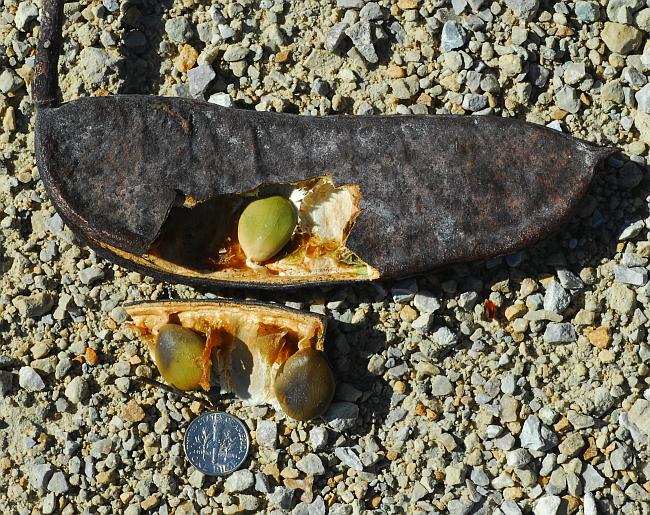Gymnocladus dioicus (L.) K. Koch
Kentucky Coffee Tree

Native
CC = 6
CW = 5
MOC = 56
© SRTurner
Gymnocladus dioicus (L.) K. KochKentucky Coffee Tree | |
 |
Native CC = 6 CW = 5 MOC = 56 |
© SRTurner |
|
Family - Fabaceae/Caesalpinioideae Habit - Trees 10-20 m tall, usually incompletely dioecious, sometimes colonial from root suckers.
Stems - Bark unarmed, shallowly grooved, silvery gray, often reddish-tinged, developing longitudinal scaly ridges and becoming dark gray on older trunks, the branches not producing short shoots but the leaves sometimes tending to be clustered toward the branch tips, the twigs stout, the winter buds inconspicuous and strongly sunken into the twig. Root nodules absent.
Leaves - Petiole 10-20 cm long, glabrous. Blades 30-90 cm long, 2 times pinnately compound, with 4-7 pairs of pinnae, each with 4-6 pairs of alternate leaflets, the lowermost pair of pinnae sometimes replaced with a pair of large leaflets. Stipules inconspicuous and scalelike, shed early. Leaflets 2-9 cm long, 1.5-5.0 cm wide, ovate to broadly elliptic, rounded to angled at the base, short-tapered or tapered to a sharply pointed tip, the margins entire and inconspicuously short-hairy, the upper surface glabrous, the undersurface finely hairy.
Inflorescences - Racemes or narrow panicles, mostly appearing terminal, 14-20 cm long, ascending to spreading, sometimes entirely staminate or pistillate on a single tree, but often with some inflorescences having mixed imperfect and perfect flowers. Flower stalks 10-35 mm long.
Flowers - Perigynous, actinomorphic, fragrant. Hypanthium 8-12 mm long, tubular to narrowly funnelform, densely hairy. Calyces of 5 sepals, these subequal, 4-7 mm long, narrowly oblong-elliptic, sharply pointed at the tip, moderately to densely hairy, not closing the flower in bud. Petals 5, 4-10 mm long, 1.5-2.5 mm wide, greenish white, densely woolly. Stamens 10, unequal in 2 alternating long and short series, the filaments not fused, hairy at the base, the anthers 1.2-1.6 mm long, attached toward the midpoint. Style short, relatively straight, the stigma oblique.
Fruits - Legumes 9-15 cm long, 2-5 cm wide, 1.0-1.5 cm thick, more or less oblong, straight or slightly curved, rounded or short-angled at the base and sometimes with a short stalk to 0.5 cm long, abruptly short-tapered to a usually sharply pointed tip, 1-4-seeded, the valves velvety when young, becoming woody and glabrous, persistent into the winter, the valves dehiscing with age along the ventral suture, seeds with a stout attachment and embedded in a green, jellylike pulp. Seeds 15-20 mm in diameter, ovate to circular, somewhat flattened but turgid, dark reddish brown, hard, shiny.
Flowering - May - June. Habitat - Forests, streambanks, bases of bluffs. Origin - Native to the U.S. Lookalikes - Juglans nigra, Ailanthus altissima, Robinia pseudoacacia, and others are trees with pinnately compound leaves. Other info. - This tree is found in scattered locations throughout most of Missouri and the U.S. Midwest. The inflorescences are distinctive but usually not seen, as they are normally high up. The leaves are more easily observed in the canopy overhead, and can be distinguished from the listed lookalikes by virtue of being doubly pinnate. The unique fruits are often found littering the ground beneath the tree, and these serve as unambiguous indication of the nearby presence of the species. The large pods normally contain only a few seeds, which are embedded in a gelatinous pulp. Photographs taken at various parts along the Katy Trail in Warren and St. Charles Counties, 3/29/2010, 3/9/2012, 7/25/2019, 2/16/2020, and 5/23/2020 (SRTurner). |